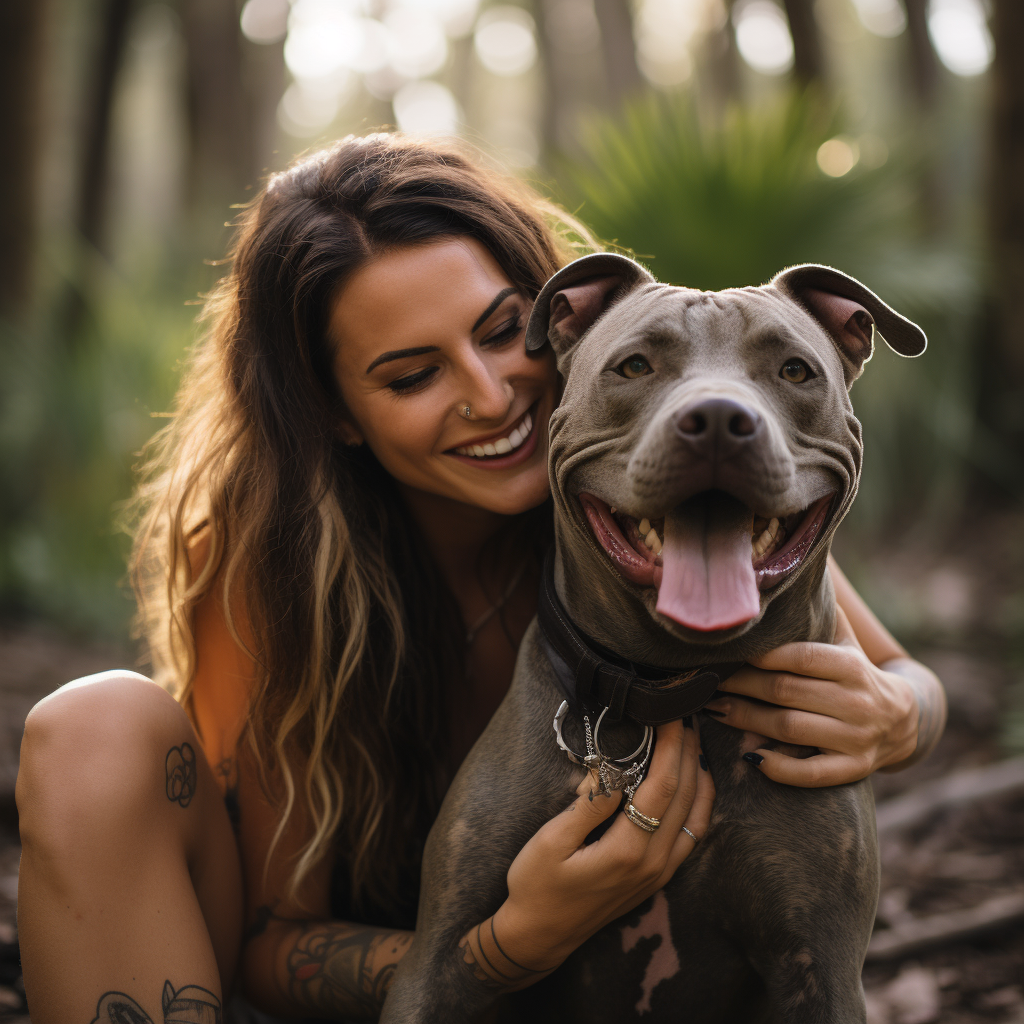
The Ultimate Pittie Choy Guide to Pit Bull Training and Advocacy
Table of Contents
- Introduction
- Understanding Your Pit Bull
- Laying the Foundations: Basic Commands
- The Importance of Consistency
- Training Techniques for "Sit", "Stay", and "Come"
- Addressing Common Training Challenges
- The Joy of Leash Training
- Harnessing the Power of Positive Reinforcement
- Building Trust: Proper Behavior Training
- The Puppy Phase: Setting Up for Success
- Tools of the Trade: Collars & Harnesses
- Creating a Pit Bull-Friendly Home Environment
- Overcoming Training Challenges
- The Social Butterfly: Socializing Your Pit Bull
- Importance of Early Socialization
- Introducing Your Pit Bull to New Experiences
- Building Positive Associations
- Dealing with Unique Pit Bull Behaviors
- Understanding Root Causes
- Management and Training Techniques
- Celebrating the Uniqueness of Your Pit Bull
- Advanced Training Techniques
- Building on Basic Commands
- Introducing Complex Behaviors
- Ensuring Continued Engagement and Stimulation
- Conclusion: Embracing the Pittie Choy Journey
Introduction
Welcome to the Pittie Choy Comprehensive Pitbull Training Guide! If you're reading this, you either share our passion for these loyal, loving, and often misunderstood companions, or you're on a journey to discover the true essence of the pit bull breed. Either way, you're in the right place.
Pit bulls, with their boundless energy, infectious enthusiasm, and expressive faces, have captured the hearts of many. However, like any dog breed, they thrive when they understand their role within a household and are given consistent guidance. Training is not just about teaching tricks or obedience; it's about building a bond, understanding your dog, and ensuring they lead a balanced and fulfilled life.
Throughout this guide, we'll delve deep into the world of pit bull training, drawing attention to their unique attributes while also addressing some common challenges faced by pit bull owners. But remember, at its core, this isn't just a training guide—it's a testament to the love, respect, and fair treatment that every pit bull deserves.
Our mission at Pittie Choy is to change the narrative surrounding pit bulls, emphasizing their loving nature, loyalty, and friendly demeanor. This guide is an extension of that mission, aiming to equip every pit bull owner with the knowledge and tools to nurture a harmonious relationship with their canine companion.
So, whether you're a first-time pit bull parent, an experienced owner looking for some additional tips, or someone advocating for the breed, this guide is designed for you. Let's embark on this rewarding journey together, celebrating every milestone, and fostering the bond that only a pit bull and their human can share.

Understanding Your Pit Bull
Every dog is unique, but when it comes to pit bulls, there's a distinctive blend of loyalty, intelligence, and playfulness that sets them apart. To truly appreciate and connect with your pit bull, it's essential to understand the breed's characteristics, address any misconceptions, and immerse yourself in the supportive pit bull community.
Recognizing Pit Bull Characteristics
Pit bulls are a versatile and adaptable breed, and while individual personalities vary, several core characteristics define them:
- Loyalty: Pit bulls are known for their unwavering loyalty. Once you earn their trust, they'll stand by your side through thick and thin.
- Intelligence: They're quick learners. Whether it's a new trick or understanding a household rule, their keen intelligence is evident.
- Playfulness: A pit bull's enthusiasm is infectious. Their love for play makes them great companions for families and individuals alike.
- Determination: When pit bulls set their mind to something, they pursue it with determination. This trait, while admirable, also means consistent training is vital.
- Affection: Contrary to some misconceptions, pit bulls are incredibly affectionate. They often think of themselves as lap dogs, regardless of their size.
Understanding these traits provides a foundation for effective training, ensuring you cater to their strengths and address any challenges head-on.
Debunking Common Myths
Pit bulls, unfortunately, have been surrounded by myths and misconceptions. As advocates for the breed, it's our duty to set the record straight:
- Myth: Pit bulls are naturally aggressive.
- Truth: Aggression is not a breed-specific trait. With proper socialization and training, pit bulls are as loving and gentle as any other breed.
- Myth: They have a locking jaw.
- Truth: Pit bulls do not have any unique jaw mechanism. Their jaw structure is like that of any other dog.
- Myth: They're not good with kids or other pets.
- Truth: When raised in a loving environment, pit bulls can be wonderful family dogs, getting along well with children and other pets.
- Myth: Pit bulls are only suitable for experienced dog owners.
- Truth: With the right resources, even first-time dog owners can raise a well-adjusted and happy pit bull.
By addressing these myths, we not only advocate for pit bulls but also help potential owners approach the breed without unfounded apprehensions.
Engaging with the Pit Bull Community
Being a part of the pit bull community is not just about owning the breed; it's about advocacy, support, and shared experiences:
- Join Local Groups: Many cities have pit bull-specific groups that organize meet-ups, training sessions, and advocacy events.
- Participate in Online Forums: Engage with other pit bull enthusiasts, share stories, ask questions, and offer support.
- Attend Advocacy Events: Whether it's a march against breed-specific legislation or an adoption drive, your participation makes a difference.
- Share Positive Stories: Use your platform, whether it's social media or a blog, to share heartwarming stories and factual information about pit bulls.
By immersing yourself in the community, you not only gain a wealth of knowledge but also contribute to changing the narrative surrounding this incredible breed.

Laying the Foundations: Basic Commands
Training your pit bull on basic commands is more than just teaching them tricks; it's about establishing communication, ensuring safety, and fostering a harmonious relationship. When approached with patience, understanding, and consistency, this foundational training can be a rewarding experience for both you and your pit bull.
The Importance of Consistency
For any dog, especially intelligent breeds like pit bulls, consistency is the key to effective training:
- Regular Training Sessions: Aim for short, regular training sessions rather than infrequent, extended ones. This keeps the training fresh in your pit bull's mind and reinforces positive behaviors.
- Consistent Command Words: Use the same words for commands. If you use "sit" one day and "down" the next for the same action, it can confuse your dog.
- Reward Consistently: Always reward the desired behavior immediately so that the connection between the action and the reward is clear.
- Unified Household Training: Ensure all family members are on the same page regarding commands, rewards, and behaviors to avoid mixed signals.
A consistent approach not only accelerates the training process but also reinforces trust between you and your pit bull.
Training Techniques for "Sit", "Stay", and "Come"
These foundational commands are essential for safety, control, and establishing basic communication:
- "Sit":
- Hold a treat close to your pit bull's nose.
- Move your hand up, allowing their head to follow the treat and causing their bottom to lower.
- Once they're sitting, say "sit", give the treat, and offer praise.
- "Stay":
- Ask your pit bull to "sit".
- Open the palm of your hand in front of you and say "stay".
- Take a few steps back. If they stay, reward with a treat and praise.
- Gradually increase the distance over time.
- "Come":
- Put a leash and collar on your pit bull.
- Go down to their level and say "come" while gently pulling on the leash.
- When they come to you, reward with a treat and affection.
- Over time, practice this command without the leash in a safe, enclosed area.
Each of these commands is fundamental for various situations, from ensuring safety during walks to fostering positive interactions at home.
Addressing Common Training Challenges
While pit bulls are eager learners, like all dogs, they may occasionally present challenges:
- Distractions: If your pit bull is easily distracted, start training in a quiet environment. Gradually introduce distractions as they become more proficient.
- Stubbornness: Sometimes, pit bulls can be a tad stubborn. If they're not responding, take a break and return to training later. Patience is key.
- Overexcitement: Pit bulls are energetic. If they're too excited, engage them in some physical activity before training to burn off excess energy.
- Fear or Anxiety: Always use positive reinforcement. If your pit bull shows signs of fear or anxiety, never force them. Understand the root cause and address it gently.
Remember, every challenge is an opportunity to understand your pit bull better and strengthen your bond.

The Joy of Leash Training
Leash training is more than a safety protocol; it's a dance between you and your pit bull, a partnership built on trust, understanding, and mutual respect. When done right, walks become a shared adventure, a time of bonding, exploration, and pure joy. But to achieve this harmony, it's crucial to approach leash training with patience, consistency, and the right techniques.
Preparing for the First Leash Walk
Before you embark on that exciting first walk, some groundwork will ensure a positive experience for both you and your pit bull:
- Select the Right Gear: Choose a sturdy, comfortable collar or harness and a leash. For pit bulls, a harness can often provide better control without putting pressure on their neck.
- Indoor Familiarization: Let your pit bull wear the collar or harness indoors for short durations, allowing them to get used to the feel without the added tension of a leash.
- Introduce the Leash: Once comfortable with the collar or harness, attach the leash, letting them roam around the house under supervision. This helps them associate the leash with freedom, not restriction.
- Practice Basic Commands: Before heading out, ensure your pit bull responds to basic commands like "sit" and "stay". This gives you foundational control during the walk.
Techniques to Prevent Pulling
One of the common challenges, especially with energetic breeds like pit bulls, is pulling on the leash:
- Start with Short Sessions: Begin with short walks around your yard or another familiar environment. This reduces the overwhelming stimuli that might excite your pit bull.
- Use the "Stop and Be a Tree" Technique: If your pit bull pulls, stop walking. Only proceed when the leash is slack. This teaches them that pulling won't get them anywhere faster.
- Redirect with Treats: Hold treats in your hand and use them to guide your pit bull's attention and direction. Reward them for walking beside you without pulling.
- Consider Training Tools: Devices like no-pull harnesses can be effective in discouraging pulling. However, always ensure any tool you use is humane and comfortable for your pit bull.
Transitioning to Outdoor Walks
Taking the training from your yard to the bustling outside world is a big step:
- Choose Quiet Times: Initially, opt for times when parks or sidewalks are less crowded, reducing the number of distractions and potential stressors.
- Stay Calm and Relaxed: Your pit bull can sense your emotions. If you're anxious, they might become tense too. Take deep breaths and maintain a calm demeanor.
- Short and Sweet: The first few outdoor walks should be brief but positive. Gradually increase the duration as your pit bull becomes more accustomed.
- Encounter Training: If your pit bull is distracted or reactive towards other dogs or people, use treats to redirect their attention to you. Over time, this can condition a positive response to such encounters.
Leash training, while it might have its challenges, is a journey. Celebrate the small victories, learn from the setbacks, and always prioritize the bond you share with your pit bull. With time and consistency, you'll both look forward to your walks as the highlight of your day.

Harnessing the Power of Positive Reinforcement
Positive reinforcement is the cornerstone of effective dog training. It revolves around the simple idea of rewarding desired behavior, making it more likely to be repeated. For a breed as responsive and eager-to-please as pit bulls, this approach not only accelerates the training process but also deepens the bond of trust between you and your furry companion.
Identifying Motivators for Your Pit Bull
Just as humans are driven by different desires, pit bulls too have their unique set of motivators:
- Treats: Many pit bulls are food-driven. Whether it's a piece of chicken, a biscuit, or a special dog treat, find out what gets their tail wagging.
- Toys: Some pit bulls might be more motivated by a favorite toy, be it a squeaky toy, a ball, or a tug rope.
- Praise: A simple "good job" coupled with a pat can go a long way. Many pit bulls thrive on the affection and validation they receive from their owners.
- Play: Sometimes, the promise of a play session—like a game of fetch or tug-of-war—can be a great motivator.
Experiment with different rewards to discover what resonates most with your pit bull. This understanding will be invaluable in all your training endeavors.
Timing and Consistency in Rewards
To ensure that positive reinforcement is effective, timing and consistency are crucial:
- Immediate Rewards: The reward should come immediately after the desired behavior, ensuring your pit bull makes the connection between the action and the positive consequence.
- Consistent Rewards: Especially in the initial stages of training a new behavior, it's essential to reward every single time the desired action is performed. As the behavior becomes more ingrained, you can gradually move to intermittent rewards.
- Be Clear in Commands: Ensure that you're rewarding the correct behavior. If you're teaching "sit," for instance, ensure the treat or praise comes when your pit bull is in the sitting position, not when they're getting up.
Celebrating Small Wins
Training is a journey, and every step forward, no matter how small, deserves celebration:
- Acknowledge Progress: Even if it's a tiny improvement, like your pit bull staying seated for a few seconds longer than before, it's progress. Celebrate it.
- Stay Positive: Positive reinforcement isn't just for your pit bull—it's for you too. Remind yourself of the successes and use them to fuel future training sessions.
- Share Achievements: Engage with the Pittie Choy community or other pit bull enthusiasts. Sharing stories of small victories can be motivating for others and provide a sense of shared accomplishment.
Embracing the power of positive reinforcement not only ensures effective training but also fosters a relationship built on mutual respect, understanding, and love. After all, at the heart of every training session is the profound bond you share with your pit bull, and every moment spent together only strengthens that connection.

Building Trust: Proper Behavior Training
Trust is the bedrock of any meaningful relationship, and it's no different with our canine companions. Proper behavior training is not just about molding your pit bull to fit into your world; it's a two-way street where both parties learn, adapt, and grow together. By addressing unwanted behaviors, reinforcing desired ones, and understanding the role of socialization, you lay the foundation for a relationship built on mutual trust and understanding.
Addressing Unwanted Behaviors
All dogs, including pit bulls, can exhibit unwanted behaviors. Understanding and addressing these behaviors is crucial:
- Identify the Cause: Before correcting a behavior, understand its root cause. Is your pit bull chewing because of teething, boredom, or anxiety?
- Avoid Punishment: Negative reinforcement can lead to fear and further behavioral issues. Instead of punishment, focus on redirecting and positive reinforcement.
- Consistent Corrections: If your pit bull jumps on guests, for example, ensure that everyone in the household responds in the same manner—by turning away, saying a firm "no," and then rewarding the dog when all four paws are on the ground.
- Seek Professional Help: If certain behaviors persist or escalate, consider consulting a professional dog trainer or behaviorist.
Techniques for Behavior Reinforcement
Reinforcing desired behaviors ensures that they become a consistent part of your pit bull's repertoire:
- Capture the Behavior: Whenever your pit bull naturally exhibits a desired behavior, reward them. If they sit calmly while waiting for food, for instance, give them praise and a treat.
- Use Cue Words: Associate desired behaviors with specific words. If you want your pit bull to lie down, use the word "down" consistently and reward them when they obey.
- Practice in Varied Environments: A command learned in the living room should also be obeyed in the park. By practicing commands in different environments, you reinforce the behavior in your pit bull's memory.
The Role of Socialization
Socialization is not just about exposing your pit bull to new experiences; it's about creating positive associations with them:
- Start Early: The critical period for dog socialization is between 3 and 14 weeks of age. If you adopt an older pit bull, however, it's never too late to start, but the approach might require more patience.
- Positive Associations: Introduce your pit bull to new experiences—people, animals, sounds, and places—in a controlled manner, ensuring that each encounter is positive.
- Group Classes: Puppy classes or group training sessions can be a great way to socialize your pit bull with other dogs and people in a structured environment.
- Monitor and Adjust: Every dog's pace of socialization is different. If your pit bull shows signs of stress or fear, take a step back and go slower.
Building trust through behavior training is a continuous process—a journey filled with learning, challenges, and numerous rewarding moments. With patience, understanding, and the right techniques, you'll foster a bond with your pit bull that's built on mutual respect and unwavering trust.

The Puppy Phase: Setting Up for Success
The puppy phase, while undeniably adorable, is a crucial period that sets the foundation for your pit bull's future behavior, temperament, and relationship with you. As those tiny paws trot around exploring their world, it's our responsibility to guide them, ensuring they grow into well-adjusted, confident, and loving adults. By focusing on early training, addressing specific puppy challenges, and establishing a routine, you're setting both you and your puppy up for long-term success.
Early Training Essentials
Starting training early equips your pit bull puppy with the tools they need to navigate their world:
- Name Recognition: Begin by teaching your puppy their name. Use it often, and reward them when they respond with eye contact.
- Basic Commands: "Sit", "Stay", and "Come" are fundamental commands that every puppy should learn. Remember, short and fun training sessions work best for puppies.
- Toilet Training: Establish a regular feeding routine and take your puppy out after every meal. Praise them generously when they do their business outside.
- Bite Inhibition: Puppies love to nibble and bite. Teach them to moderate the force of their bite by letting out a yelp if they bite too hard during play.
Addressing Puppy-Specific Challenges
Puppies, with their boundless energy and curiosity, can present unique challenges:
- Chewing: Teething puppies will chew anything they can find. Provide them with appropriate chew toys and puppy-proof your home.
- Separation Anxiety: Start by leaving your puppy alone for short durations, gradually increasing the time. This teaches them that you'll always return.
- Socialization: Expose your puppy to various people, animals, and environments. Ensure each experience is positive to build their confidence.
- Overexcitement: Puppies can get overly excited during play or when meeting new people. Teach them to sit and calm down before they get any attention.
Building a Routine
A routine provides security and predictability for your puppy:
- Feeding Times: Stick to regular feeding times. This not only aids digestion but also helps in establishing a toilet routine.
- Training Sessions: Incorporate short training sessions into your puppy's daily routine. This consistency accelerates learning.
- Play and Rest: Ensure your puppy has a balance of playtime and rest. Overstimulation can lead to cranky behavior, while adequate play ensures they're mentally and physically stimulated.
- Night Routine: Establish a bedtime routine, signaling to your puppy that it's time to wind down. This might include a final toilet break, a calm play session, or a bedtime story (yes, some pups love this!).
The puppy phase, while demanding, is one of the most rewarding periods in a dog owner's journey. Every day presents new challenges and even more heartwarming moments. By setting a strong foundation during this time, you ensure a lifetime of happiness, understanding, and mutual respect with your pit bull.

Tools of the Trade: Collars & Harnesses
Whether you're taking your pit bull for a leisurely walk or embarking on a training session, the right collar or harness is crucial. These tools, when chosen and used correctly, ensure your pit bull's safety, comfort, and overall well-being. By understanding how to select the right equipment, utilize safe training techniques, and address common issues, you're setting the stage for many pleasant walks and training sessions with your beloved pit bull.
Selecting the Right Collar or Harness
With a myriad of options available, choosing the right collar or harness can be overwhelming. Here's a guide to help you make an informed decision:
- Fit: Whether it's a collar or a harness, ensure it fits snugly without being too tight. You should be able to fit two fingers between the collar/harness and your pit bull's skin.
- Material: Opt for durable materials like leather or nylon. Ensure there are no sharp edges that might irritate your pit bull's skin.
- Type:
- Flat Collar: Suitable for well-trained pit bulls who don't pull on the leash.
- Harness: Offers better control for pit bulls that pull. It also distributes pressure across the chest, reducing the risk of injury.
- Martingale Collar: Provides slight constriction when the dog pulls, making it a training-friendly option.
- Reflective Elements: If you often walk your pit bull during dawn or dusk, choose a collar or harness with reflective elements for added safety.
Safe Usage and Training Techniques
Using a collar or harness safely and effectively is paramount:
- Regular Checks: Frequently inspect the collar or harness for signs of wear and tear. Replace it if it's frayed or damaged.
- Avoid Continuous Wear: Don't let your pit bull wear their collar or harness all the time, especially if they're unsupervised. This reduces the risk of them getting caught on something.
- Positive Associations: Introduce the collar or harness in a positive environment. Let your pit bull sniff it, and reward them with treats when you put it on.
- Training: Use the collar or harness as a training tool, not a restraint. For instance, if using a training collar, ensure it's utilized correctly, providing gentle corrections and not causing discomfort.
Addressing Common Issues
While collars and harnesses are essential tools, they might present some challenges:
- Chafing: If you notice your pit bull has areas of irritated skin, consider switching to a different style or material.
- Escape Artists: Some pit bulls are adept at wriggling out of their collars or harnesses. A proper fit is essential, but you might also consider styles designed to prevent escapes.
- Pulling: If your pit bull continues to pull even with a harness, consider training sessions specifically aimed at leash behavior or consult a professional dog trainer.
Collars and harnesses, while simple tools, play a pivotal role in your pit bull's life. By choosing the right one and using it responsibly, you ensure your pit bull's safety, comfort, and happiness, whether on a walk, during training, or simply lounging at home.

Creating a Pit Bull-Friendly Home Environment
Your home is not just a dwelling; for your pit bull, it's their sanctuary, a place where they feel secure, loved, and understood. Crafting a pit bull-friendly environment goes beyond just providing food and shelter. It's about creating spaces where they can thrive, setting clear boundaries, and ensuring that any hiccups along the way are addressed with patience and understanding.
Home Training Basics
Home training is the foundation for a harmonious coexistence between you and your pit bull:
- Routine: Just like humans, pit bulls find comfort in routine. Establish consistent times for feeding, potty breaks, play, and rest.
- Feeding Area: Designate a specific spot in your home for meals. This not only helps in establishing routine but also prevents any food-related territorial behaviors.
- Rest Area: Ensure your pit bull has a comfortable place to rest, be it a dog bed, a designated couch spot, or a crate if they're crate-trained.
- Toys and Engagement: Have a variety of toys available. This not only keeps them entertained but also prevents them from resorting to destructive behaviors out of boredom.
Establishing Boundaries and Safe Zones
Boundaries help your pit bull understand where they can and cannot go, while safe zones provide them with a space where they can retreat and feel secure:
- Clear Commands: Use consistent commands like "off" for furniture they're not allowed on or "out" for rooms they shouldn't enter.
- Physical Barriers: Baby gates or closed doors can be used to block off areas that are off-limits.
- Safe Zones: Designate a specific area, like a crate or a particular room, as your pit bull's safe zone. This is a place they can retreat to if they're feeling overwhelmed or need some downtime.
- Respect Their Space: Ensure everyone in the household understands the importance of the safe zone and refrains from disturbing your pit bull when they're in it.
Addressing and Preventing Accidents
Accidents, be it a broken vase or a potty mishap, are bound to happen. It's essential to address them with patience and understanding:
- Avoid Punishment: If you didn't catch your pit bull in the act, punishing them after the fact is ineffective. They won't make the connection between the punishment and the accident.
- Clean Accidents Thoroughly: If your pit bull has a potty accident, clean the area thoroughly to remove any lingering scents, preventing them from being attracted to the same spot in the future.
- Positive Reinforcement: Reward your pit bull for desired behaviors, like using the potty outside or playing with their toys instead of household items.
- Be Proactive: If you notice patterns in accidents (like a specific time of day when potty accidents happen), adjust your routine to prevent them. For instance, schedule an additional potty break.
Creating a pit bull-friendly home is a continuous journey of learning, adapting, and growing together. With understanding, patience, and consistent training, your home becomes more than just a living space; it's a haven of love, trust, and mutual respect.

Overcoming Training Challenges
Every dog breed comes with its set of training challenges, and pit bulls are no exception. While they are known for their intelligence, loyalty, and eagerness to please, some specific issues can arise during their training. Understanding these challenges, tailoring solutions for success, and knowing when to seek expert help can pave the way for a smoother training journey with your pit bull.
Common Pit Bull-Specific Issues
While every pit bull is an individual, some common challenges are often reported by pit bull owners:
- Stubbornness: Sometimes, pit bulls can display a stubborn streak, especially if they're not motivated or find the training boring.
- High Energy Levels: Their zest for life means they have abundant energy, which, if not channeled properly, can lead to hyperactivity during training sessions.
- Prey Drive: Some pit bulls might have a higher prey drive, which can be a challenge, especially during outdoor training or walks.
- Sensitivity: Contrary to some stereotypes, many pit bulls are incredibly sensitive and may not respond well to harsh training methods.
Tailored Solutions for Success
Knowing the challenges is half the battle. Here's how to address them:
- Keep Training Engaging: If your pit bull shows signs of stubbornness, switch up the training routine. Use different treats, introduce new toys, or change the training environment.
- Channel Energy Positively: Before a training session, engage your pit bull in a vigorous play session. A game of fetch or tug can help burn off excess energy, making them more focused during training.
- Train Recall Religiously: Given their potential prey drive, a solid recall is crucial. Practice this command consistently and reward generously when obeyed.
- Positive Reinforcement: Given their sensitive nature, always opt for positive reinforcement techniques. Harsh methods can lead to fear or aggression.
Seeking Expert Help
Sometimes, despite your best efforts, challenges persist:
- Professional Dog Trainers: If certain behaviors don't improve, consider hiring a professional dog trainer. They can provide a fresh perspective and might notice things you've missed.
- Behaviorists: For deeper behavioral challenges, especially those rooted in fear or trauma, a canine behaviorist might be more appropriate.
- Pit Bull-Focused Groups: Organizations or communities, like the Pittie Choy community, can offer invaluable insights, tips, and support based on their experiences with pit bulls.
- Continued Learning: Attend workshops, read books, or watch tutorials. The more you learn, the better equipped you are to address challenges.
Training challenges, while occasionally frustrating, offer an opportunity for growth, both for you and your pit bull. With patience, understanding, and the right strategies, these challenges can be transformed into triumphant milestones in your shared journey.

The Social Butterfly: Socializing Your Pit Bull
Socialization isn't just about letting your pit bull meet other dogs or people. It's about equipping them with the experiences, tools, and confidence to navigate the world around them positively and safely. Given the misconceptions surrounding pit bulls, ensuring they're well-socialized not only benefits them but also helps in challenging negative stereotypes.
Importance of Early Socialization
The foundations of a well-adjusted adult pit bull lie in their puppyhood experiences:
- Critical Period: The most crucial socialization period for dogs is between 3 to 14 weeks. During this time, puppies are especially receptive to new experiences.
- Building Confidence: Proper socialization ensures your pit bull is confident, reducing the chances of fear-induced aggressive behaviors.
- Preventing Fear and Phobias: Dogs that aren't well-socialized might develop fears and phobias, leading to behavioral challenges in adulthood.
- Promoting Positive Breed Image: A well-socialized pit bull serves as an ambassador for the breed, showcasing their loving, friendly, and sociable nature.
Introducing Your Pit Bull to New Experiences
Variety is the spice of life, and for your pit bull, it's also the foundation of effective socialization:
- Diverse Environments: Expose your pit bull to various environments—parks, beaches, city streets, and countryside.
- Meeting New People: Let them meet people of different ages, sizes, and ethnicities. This includes children, the elderly, and people wearing hats, uniforms, or carrying bags.
- Interaction with Animals: Introduce your pit bull to other dogs, both large and small. If possible, also let them meet other animals like cats, birds, or horses.
- Different Sounds: Play recordings of sounds like fireworks, traffic noise, or thunderstorms. Start at a low volume and gradually increase, ensuring your pit bull remains calm.
Building Positive Associations
Every new experience should be a positive one:
- Use Treats and Praise: Whenever your pit bull encounters something new, reward them with treats or praise, building a positive association.
- Go At Their Pace: Never force your pit bull into a situation they're uncomfortable with. If they show signs of fear or uncertainty, take a step back and approach the situation more gradually.
- Consistent Reassurance: Your pit bull looks to you for cues. If you're calm and confident, they're more likely to mirror those feelings.
- Monitor Body Language: Be attuned to your pit bull's body language. If they're showing signs of stress, such as excessive panting, pinned ears, or a tucked tail, it might be time to leave the situation.
Socialization is an ongoing journey, one that continues well beyond puppyhood. With patience, persistence, and a focus on positive experiences, your pit bull will not only be a well-adjusted member of the canine community but also a shining testament to the loving nature of the breed.

Dealing with Unique Pit Bull Behaviors
Pit bulls, like any breed, come with their own set of unique behaviors. Some are endearing quirks, while others might pose challenges. By understanding the root causes of these behaviors, employing effective management and training techniques, and celebrating their individuality, you can foster a harmonious and loving relationship with your pit bull.
Understanding Root Causes
Before addressing any behavior, it's essential to understand its origin:
- Stubbornness: Sometimes perceived as stubborn, a pit bull might simply be unsure of what's being asked or not find the task motivating enough.
- High Energy Levels: A pit bull's zest for life often translates into high energy levels. If not channeled properly, this can lead to hyperactivity or destructive behaviors.
- Prey Drive: Historically, some pit bulls were bred for activities that required a high prey drive. This instinct might manifest when they see smaller animals or moving objects.
- Loyalty and Protectiveness: While pit bulls are generally friendly, their loyalty to their family might make them wary of strangers or new situations.
Management and Training Techniques
Understanding the behavior is the first step. Here's how to address them:
- Positive Reinforcement: Reward desired behaviors. If your pit bull recalls from chasing a squirrel, shower them with praise and treats.
- Engagement: Keep their minds and bodies engaged. Puzzle toys, agility training, or regular play sessions can help channel their energy positively.
- Consistent Training: Ensure commands and training techniques are consistent across all family members and caregivers.
- Safe Spaces: If your pit bull is wary of strangers, give them a designated safe space where they can retreat and relax.
- Desensitization: Gradually expose your pit bull to triggers in controlled environments. For instance, if they're reactive to other dogs, start with distant observations, rewarding calm behavior, and progressively decreasing the distance.
Celebrating the Uniqueness of Your Pit Bull
While addressing challenges is essential, it's equally important to celebrate what makes your pit bull unique:
- Embrace Their Quirks: Whether it's the adorable way they tilt their head when curious or their love for belly rubs, every pit bull has quirks that make them special.
- Share Their Stories: Use platforms like the Pittie Choy community to share heartwarming tales, showcasing the loving nature of pit bulls.
- Educate Others: Help dispel myths about pit bulls by educating friends, family, and strangers about their true nature.
- Cherish Every Moment: Every day with your pit bull is a gift. From the mischievous twinkle in their eyes to their unwavering loyalty, there's so much to celebrate.
Understanding, managing, and celebrating the unique behaviors of pit bulls is a journey filled with challenges, learning opportunities, and countless heartwarming moments. With patience, love, and the right strategies, you'll forge a bond that's built on mutual respect, understanding, and sheer joy.

Advanced Training Techniques
After mastering the basics, many pit bull owners seek to challenge and further engage their dogs with advanced training techniques. Not only do these techniques enhance obedience and responsiveness, but they also provide mental stimulation, keeping your pit bull engaged and content. By building on basic commands, introducing more complex behaviors, and ensuring continued engagement, you'll develop a bond with your pit bull that's rooted in mutual respect and understanding.
Building on Basic Commands
With a solid foundation in place, it's time to raise the bar:
- Extended Stay: Challenge your pit bull to stay in position for longer durations or while you move out of sight.
- Distraction Training: Ask for basic commands, like "Sit" or "Stay", in increasingly distracting environments to reinforce their focus on you.
- Advanced Recall: Incorporate challenges during recall, such as calling your pit bull when they're engaged in play or from greater distances.
Introducing Complex Behaviors
Take your training to the next level by introducing more intricate tasks:
- Trick Training: Teach fun tricks like "Roll Over", "Play Dead", or even "Fetch the Remote". It's engaging for your pit bull and can be a fun party trick!
- Agility Training: Set up agility courses with jumps, tunnels, and weave poles. This not only challenges them mentally but also provides excellent physical exercise.
- Task-Oriented Training: Train your pit bull to perform specific tasks, such as bringing you the newspaper, turning off lights, or even helping with laundry. It's functional and fosters a sense of purpose.
- Scent Work: Utilize your pit bull's keen sense of smell by engaging them in activities like hide and seek with toys or treats.
Ensuring Continued Engagement and Stimulation
To maintain enthusiasm and prevent boredom, it's crucial to keep the training fresh and engaging:
- Rotate Activities: Instead of sticking to a single training routine, rotate between different activities to keep things unpredictable and exciting for your pit bull.
- Challenge Their Minds: Use puzzle toys or DIY challenges at home. For example, hide treats under cups and shuffle them around, letting your pit bull pick the right one.
- Join Training Groups: Enroll in advanced training classes or join pit bull-focused training groups. It provides socialization and exposes your pit bull to new training techniques.
- Set Goals: Whether it's mastering a new trick every month or aiming for an agility championship, setting goals keeps both you and your pit bull motivated.
Advanced training isn't just about teaching new tricks or commands. It's a commitment to continuous growth, mutual learning, and deepening the bond you share with your pit bull. With dedication, patience, and a sprinkle of creativity, you'll witness your pit bull's potential unfold in the most delightful ways.

Conclusion: Embracing the Pittie Choy Journey
Training and socializing your pit bull, like any cherished journey, is filled with moments of joy, challenges, and invaluable learning. As you navigate through each phase, from understanding the unique quirks of your pit bull to mastering advanced training techniques, remember that you're not just raising a well-behaved dog; you're also challenging stereotypes and playing a pivotal role in reshaping the narrative surrounding this incredible breed.
Pittie Choy is more than just a brand; it's a movement, a community, and a beacon of hope for pit bulls worldwide. Every product you purchase, every story you share, and every myth you debunk takes us a step closer to a world where pit bulls are cherished for their loyalty, love, and resilience.
By supporting Pittie Choy, you're not only equipping yourself with quality products that resonate with your values, but you're also contributing to a larger cause. Every purchase funnels back into our mission, helping raise awareness and transform perceptions. Moreover, a portion of our proceeds goes directly to associations dedicated to the rescue and rehabilitation of pit bulls.
So, as you embrace the training journey with your pit bull, remember that you're backed by a community that shares your passion, understands your challenges, and celebrates your successes. Together, with every purchase and every shared story, we inch closer to a world where every pit bull finds a loving home, free from prejudice and filled with boundless love.
Support the cause. Wear your love for pit bulls with pride. Shop Pittie Choy now.

Be a Part of the Change
Support the cause and wear your love for Pitbulls. Shop the 'Pitbull Mom' collection today
-
Educate & Advocate
Our products do more than just look good; they educate and advocate. Every item tells a story about pitbulls, challenging myths and spreading awareness about their true nature. By choosing our merchandise, you're not just making a style statement; you're becoming a voice for pitbulls, helping to reshape perceptions and promote a more informed understanding of this wonderful breed.
-
Inspire
Our products are designed to inspire. From the joyful images of smiling pitbulls to the powerful messages of love and resilience, each item serves as a reminder of the positive impact these dogs have on our lives. By wearing or using our products, you inspire others to see the beauty and loyalty of pitbulls, fostering a community of understanding and support.
-
Give Back
When you shop with us, you're contributing to a greater cause. A portion of every sale goes to pitbull rescue organizations and advocacy groups. Your purchase helps in providing care, shelter, and a chance at a loving home for pitbulls in need.
Share Your Story!
We believe that every story is powerful, and we want to hear yours. Whether you're a Pitbull owner, advocate, or simply someone who believes in our cause, your voice matters. Share your story, photos, or videos with us, and let's create a wave of understanding and compassion that changes perceptions.
Our Special Collections
-

Smiling Pitbull - Cute & Happy Pitbull Smiles
Welcome to our Smiling Pitbull Collection at Pittie Choy. This range isn't...
-

Pit bull Wall Art
Step into the world of our Pit Bull Wall Art collection at...
-

Don't Judge Pitbull Collection - Advocate for Pitbulls and Promote Understanding
Discover our "Don't Judge Pitbull" Collection at Pittie Choy. Here, we challenge...
-

Pitbull Dad Collection
Embark on the Pitbull Dad Journey Embark on a journey of pride...
-

Pitbull Mom
If you’re proud to call yourself a Pitbull Mom, you’re more than...
-

🐾 DON'T BULLY MY BREED - 30% OFF SALE 🐾
Welcome to the Don't Bully My Breed Collection, a unique range dedicated to...






